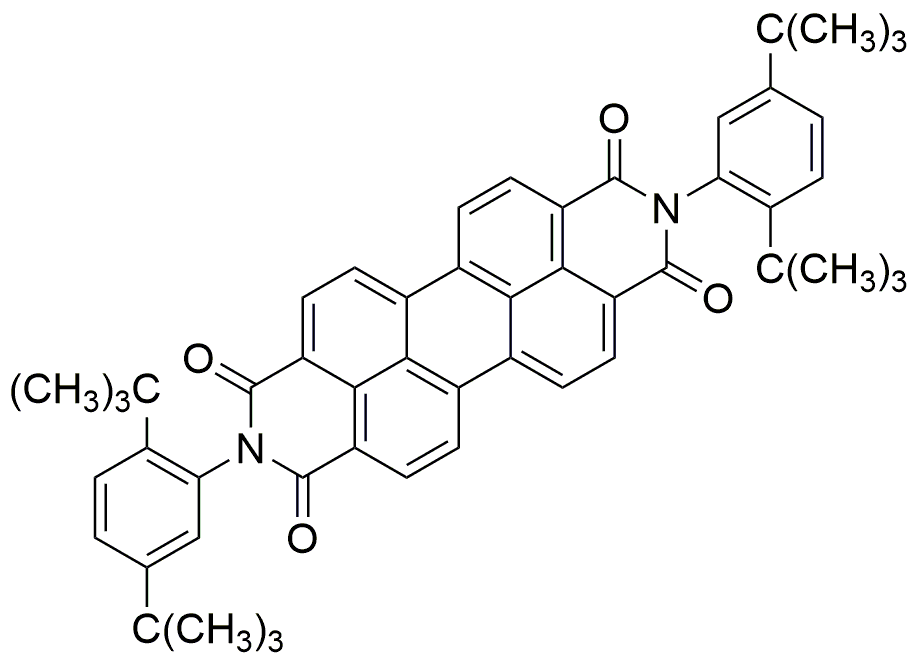N,N?-Bis(2,5-di-tert-butylphenyl)-3,4,9,10-perylenedicarboximide is widely utilized in research focused on:
- Organic Photovoltaics: This compound serves as an effective electron acceptor in organic solar cells, enhancing energy conversion efficiency and stability.
- Fluorescent Dyes: Its strong fluorescence properties make it ideal for use in various imaging techniques, including fluorescence microscopy, aiding researchers in visualizing biological processes.
- Light Emitting Diodes (LEDs): The compound is employed in the development of high-performance organic LEDs, providing bright and efficient light sources for displays and lighting applications.
- Photonic Devices: It is used in the fabrication of photonic devices, such as waveguides and sensors, which are crucial for telecommunications and data transmission technologies.
- Environmental Monitoring: The compound's stability and sensitivity to environmental changes make it suitable for developing sensors that monitor pollutants and other environmental factors.
General Information
Properties
Safety and Regulations
Applications
N,N?-Bis(2,5-di-tert-butylphenyl)-3,4,9,10-perylenedicarboximide is widely utilized in research focused on:
- Organic Photovoltaics: This compound serves as an effective electron acceptor in organic solar cells, enhancing energy conversion efficiency and stability.
- Fluorescent Dyes: Its strong fluorescence properties make it ideal for use in various imaging techniques, including fluorescence microscopy, aiding researchers in visualizing biological processes.
- Light Emitting Diodes (LEDs): The compound is employed in the development of high-performance organic LEDs, providing bright and efficient light sources for displays and lighting applications.
- Photonic Devices: It is used in the fabrication of photonic devices, such as waveguides and sensors, which are crucial for telecommunications and data transmission technologies.
- Environmental Monitoring: The compound's stability and sensitivity to environmental changes make it suitable for developing sensors that monitor pollutants and other environmental factors.
Documents
Safety Data Sheets (SDS)
The SDS provides comprehensive safety information on handling, storage, and disposal of the product.
Product Specification (PS)
The PS provides a comprehensive breakdown of the product’s properties, including chemical composition, physical state, purity, and storage requirements. It also details acceptable quality ranges and the product's intended applications.
Certificates of Analysis (COA)
Search for Certificates of Analysis (COA) by entering the products Lot Number. Lot and Batch Numbers can be found on a product’s label following the words ‘Lot’ or ‘Batch’.
*Catalog Number
*Lot Number
Certificates Of Origin (COO)
This COO confirms the country where the product was manufactured, and also details the materials and components used in it and whether it is derived from natural, synthetic, or other specific sources. This certificate may be required for customs, trade, and regulatory compliance.
*Catalog Number
*Lot Number
Safety Data Sheets (SDS)
The SDS provides comprehensive safety information on handling, storage, and disposal of the product.
DownloadProduct Specification (PS)
The PS provides a comprehensive breakdown of the product’s properties, including chemical composition, physical state, purity, and storage requirements. It also details acceptable quality ranges and the product's intended applications.
DownloadCertificates of Analysis (COA)
Search for Certificates of Analysis (COA) by entering the products Lot Number. Lot and Batch Numbers can be found on a product’s label following the words ‘Lot’ or ‘Batch’.
*Catalog Number
*Lot Number
Certificates Of Origin (COO)
This COO confirms the country where the product was manufactured, and also details the materials and components used in it and whether it is derived from natural, synthetic, or other specific sources. This certificate may be required for customs, trade, and regulatory compliance.


